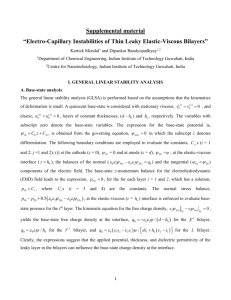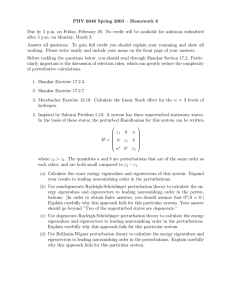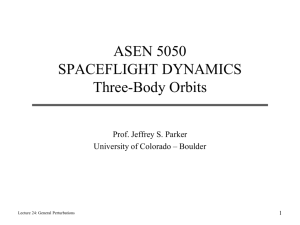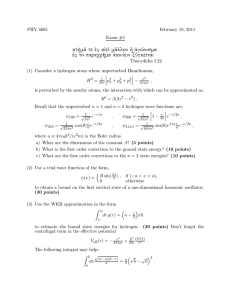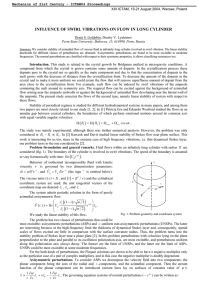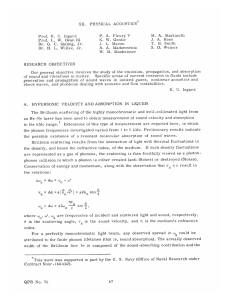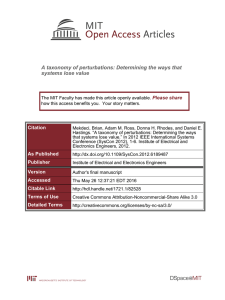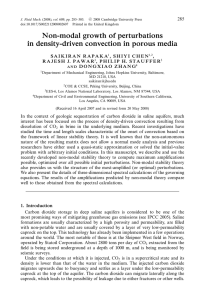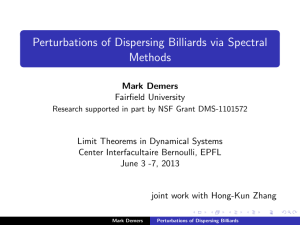VIII. ACOUSTICS* Dr. M. A. Martinelli
advertisement
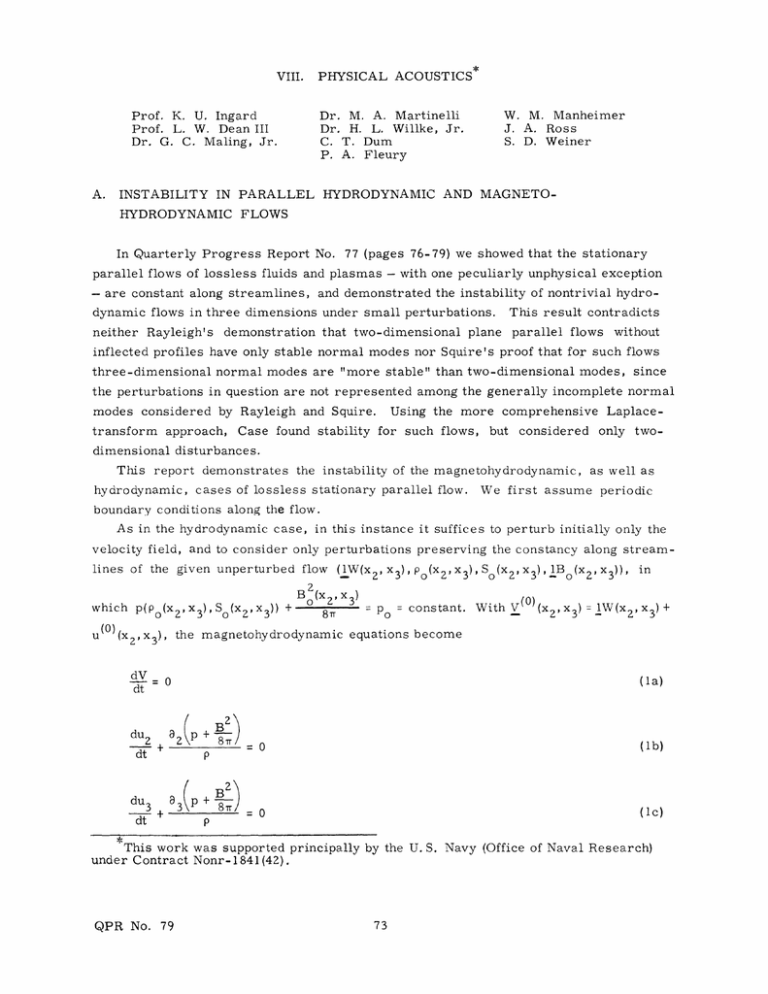
VIII. W. M. Manheimer J. A. Ross S. D. Weiner Dr. M. A. Martinelli Dr. H. L. Willke, Jr. C. T. Dum P. A. Fleury Prof. K. U. Ingard Prof. L. W. Dean III Dr. G. C. Maling, Jr. A. PHYSICAL ACOUSTICS* INSTABILITY IN PARALLEL HYDRODYNAMIC AND MAGNETO- HYDRODYNAMIC FLOWS In Quarterly Progress Report No. 77 (pages 76-79) we showed that the stationary parallel flows of lossless fluids and plasmas - with one peculiarly unphysical exception - are constant along streamlines, and demonstrated the instability of nontrivial hydro- dynamic flows in three dimensions under small perturbations. demonstration that two-dimensional plane Rayleigh's neither This result contradicts parallel flows without inflected profiles have only stable normal modes nor Squire's proof that for such flows three-dimensional normal modes are "more stable" than two-dimensional modes, since the perturbations in question are not represented among the generally incomplete normal modes considered by Rayleigh and Squire. transform approach, Laplace- Using the more comprehensive Case found stability for such flows, but considered only two- dimensional disturbances. This report demonstrates the instability of the magnetohydrodynamic, hydrodynamic, cases of lossless stationary parallel flow. as well as We first assume periodic boundary conditions along the flow. As in the hydrodynamic case, in this instance it suffices to perturb initially only the velocity field, and to consider only perturbations preserving the constancy along streamlines of the given unperturbed flow (lW(x 2 , x 3 ), Po(X 2 , x 3 ),So(x B (xz' +x 08 +B which p(po(x 2 ,x 3),S(x u ( 0 ) (x 2 ,x 3 + 82 P + dt 3 dt x 3) 3 P o = constant. With V () 3 ), 1B o (x 2 ,x (x 2 , x 3) 3)) =1W(x , in 2 , x 3 )+ (la) dt du ,x ), the magnetohydrodynamic equations become dVS= 0 du z 2 1 = 0 (Ib) = 0 (c) p a + p3 + -TZ p *This work was supported principally by the U. S. Navy (Office of Naval Research) under Contract Nonr-1841(42). QPR No. 79 (VIII. PHYSICAL ACOUSTICS) dp d = -p(V.- u) (Id) dB dS P dt in which dt d = (le) a + u2 + u3 3' In terms of the Lagrangian coordinates X(x,t) (i. e., the solution of dX/dt = 0 with the property that X(x, 0) = x) we have at once S(X, t) = So(X 2 , X 3 ) B (Za) Bo (X, t) =-o (X 2 , X 3) p pO (2b) t (V7 u)(X, t') dt'). p(X,t) = p (X 2 , X 3 ) exp(- (2c) 0 Let us restrict our attention to perturbations u(0)(x 2 x 3 ) such that V if we neglect in Eq. 2c the change of 7V u(0) = 0. Then u from its initial value with the passage of time, we get B (X,t) p(X, t) + 8r = P(Po(X 2 , X 3 ), S(X 2, X 3)) B ( 2 ) (X ,X) o (X2 X 3 8rr = po = constant, so that Eqs. la, Ib, and Ic become dV dt du2 dt du3 dt 0, so that V(X,t) = V(0)(X 2 , X 3) = W(X 2 , X 3) + u0) (X2, X3) u2 , t) = u (0) 2 (X) (4b) S(0) u3(X, t) = u3(X). With the aid of the well-known inversion formula x(X, t) = X + V(X, t') dt', we find that in this approximation QPR No. 79 (4a) (4c) (VIII. fu u V 0 ) (X u u- 2, a iu 0 )) (X X3 0) PHYSICAL ACOUSTICS) 0) (X(x,t)) dt' X3 ) (X2 , X3 Roughly speaking, then, Eqs. 4b and 4c approximate the solutions to Eqs. lb and ic to 0) (Eq. 4a is exact in terms of X). second order in certain derivatives of the u( The instability is now at hand, for u 1l(x,t) = V 1 (X(x, t) - W(x) = u( 0 )(X, (x, t)) + [W(X(x, t))-W(x)]. (6) 1 The first term in Eq. 6 will remain small if it is so initially. We can always make (0 ) so that streamlines sup W(x) - inf W(x) by choosing u x x starting sufficiently near the location of one extremum of W(x) pass at some later time sufficiently close to the location of the other extremum. Initially small perturbations the bracketted term approach are thus amplified by this mechanism up to the level of the spatial variation of the unperturbed flow. The latter will be small only if the unperturbed flow is essentially a Galilean translate of the null flow W = 0. Although Eq. 6 is not an exact solution, it is better than a linearized solution in that it rounds off instead of growing indefinitely large with time. For comparison with Eq. 6, and to better exhibit the initial growth of the perturbation, we write the linearized solution corresponding to Eq. 6. Such a solution will not exist if W has large jump discon- tinuities, since in that case the more accurate solution (Eq. 6) will immediately jump from small to macroscopic levels at arbitrarily small t > 0. We extract the linearized solution from Eq. 6 by treating X(x, t) - x as a small parameter and keeping lowest order terms. If W is differentiable, we obtain with the aid of Eq. 5 ul( t) u1 )(x) + ((x,t)-x) 0u(0) u())(x)- VW(x) + (0)(x) dt' W(x) +... ) W(x), t(u°)(x) Vo so that u 1 exhibits linear growth with time in the linearized approximation. H. L. Willke, Jr. QPR No. 79

